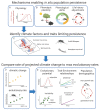How will mosquitoes adapt to climate warming?
- PMID: 34402424
- PMCID: PMC8370766
- DOI: 10.7554/eLife.69630
How will mosquitoes adapt to climate warming?
Abstract
The potential for adaptive evolution to enable species persistence under a changing climate is one of the most important questions for understanding impacts of future climate change. Climate adaptation may be particularly likely for short-lived ectotherms, including many pest, pathogen, and vector species. For these taxa, estimating climate adaptive potential is critical for accurate predictive modeling and public health preparedness. Here, we demonstrate how a simple theoretical framework used in conservation biology-evolutionary rescue models-can be used to investigate the potential for climate adaptation in these taxa, using mosquito thermal adaptation as a focal case. Synthesizing current evidence, we find that short mosquito generation times, high population growth rates, and strong temperature-imposed selection favor thermal adaptation. However, knowledge gaps about the extent of phenotypic and genotypic variation in thermal tolerance within mosquito populations, the environmental sensitivity of selection, and the role of phenotypic plasticity constrain our ability to make more precise estimates. We describe how common garden and selection experiments can be used to fill these data gaps. Lastly, we investigate the consequences of mosquito climate adaptation on disease transmission using Aedes aegypti-transmitted dengue virus in Northern Brazil as a case study. The approach outlined here can be applied to any disease vector or pest species and type of environmental change.
Keywords: adaptation; climate change; ecology; evolutionary rescue; mosquito; pest; vector.
© 2021, Couper et al.
Conflict of interest statement
LC, JF, JC, MC, MH, DK, NN, MS, ES, LU, ME, EM No competing interests declared
Figures



References
-
- Almagro A, Oliveira PTS, Rosolem R, Hagemann S, Nobre CA. Performance evaluation of eta/HadGEM2-ES and eta/MIROC5 precipitation simulations over Brazil. Atmospheric Research. 2020;244:105053. doi: 10.1016/j.atmosres.2020.105053. - DOI
Publication types
MeSH terms
Grants and funding
LinkOut - more resources
Full Text Sources
Other Literature Sources
Medical

